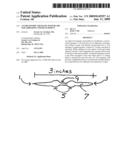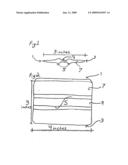Patent application title: An Ergonomic squeegee with blade for adhesions and detachment
Inventors:
Jeremy Lee Graham, Sr. (Hardeeville, SC, US)
IPC8 Class: AB32B3700FI
USPC Class:
156510
Class name: Adhesive bonding and miscellaneous chemical manufacture surface bonding means and/or assembly means therefor with cutting, punching, piercing, severing, or tearing
Publication date: 2009-06-11
Patent application number: 20090145557
method of modifying a conventional squeegee. A
novel hand tool for adherence assistance and cutting of tapes with
threads incorporated into it. The squeegee is approximately 4 inches by 3
inches and held in one hand. While rubbing over the surface of the tape
being adhered with the 4 inch elongated side causing friction heat for
the glue of the tape to adhere. Turning the squeegee around to the other
elongated 4 inch side where there is a cutting blade to separate the tape
from the roll. The squeegee will provide a simplified and more
commercially feasible method for a hand held tool for adherence and
separation of tapes.Claims:
1. This invention is a handheld plastic squeegee with a stiff edge to
assist in adherence of tapes. By rapidly rubbing back and forth down the
length of the tape onto the surface being adhered to. This produces
friction heat helping the glue of the tape to stick. Further more the
opposite side of the squeegee has a cutting edge for which to cut tape
that has threads incorporated into it for strength. The cutting edge of
the squeegee defines the true point of the invention. After pulling the
length of tape desired and applying it to the surface, firmly put
pressure on the cutting edge onto the tape and pull the roll of tape away
cutting a clean edge from the roll, then with a rubbing motion of the
stiff edged side of the squeegee adhering the tape to the surface. This
most simplest of tools has been improved due to the addition of the
cutting edge I Jeremy Lee Graham Sr have designed for the squeegee's
performance.Description:
FIELD OF INVENTION
[0001]The invention relates to squeegees, which are used for tape adhesion. In particular the invention involves a flexible plastic squeegee. On one side of the squeegee is used for creating friction for more desirable tape adhesion. On the other side of the squeegee a blade used for cutting the tape used by HVAC for ductwork, the special tape in question has threads incorporated inside of it; therefore the bladed side of the squeegee is needed because the tape in unable to be torn.
BACKGROUND OF THE INVENTION
[0002]The art of HVAC duct installation requires the use of many types of tapes for many purposes. The type of tape in question has threads incorporated into it for strength. Until now the installers of ductwork have used a squeegee with two sides edged used for creating friction which causes heat that makes the glue of the tape more adhesive. After applying the tape to the length required the tape must then be cut with a knife. Therefore the invention in question minimizes the number or tools used and handled for faster and more productive installation. The new tool is not restricted to HVAC it has many other user in many other fields.
BRIEF DESCRIPTION OF THE DRAWINGS
[0003]A more complete understanding of the invention can be understood by referring to the following detailed description and with the accompanying drawings wherein:
[0004]FIG. 1 is an end on view of a squeegee embodiment of the present invention and
[0005]FIG. 2 is a broad or top view of the squeegee embodiment showing over all view of the hand tool.
DETAILED DESCRIPTION OF THE DRAWINGS
[0006]Referring now to the drawings. Illustrations are indicated by like reference numerals.
[0007]FIG. 1 illustrates a side view or an end on view of the hand tool. 1 of the invention consists of a metal cutting blade protruding from the thinner edge of the squeegee, this edge is for cutting the surface being applied. The surface applied is a tape with threads incorporated. This blade 1 is used for easy removal of the tape in various lengths. 3 is the equal and opposite side of the squeegee used for smoothing the tape to the surface being applied. The gripping ridges 5 assists in comfort and no slip grip when pressure is being applied to 1 blade. 9 the central section where the fingers and thumb will be placed for use of the squeegee.
[0008]FIG. 2. illustrates a broad or top view of the invention. 7 where the squeegee starts out thicker and thins down to an edge 3. A further important detail of the cutting edge 1 is the part of the tool that makes this squeegee valuable to the user.
Claims:
1. This invention is a handheld plastic squeegee with a stiff edge to
assist in adherence of tapes. By rapidly rubbing back and forth down the
length of the tape onto the surface being adhered to. This produces
friction heat helping the glue of the tape to stick. Further more the
opposite side of the squeegee has a cutting edge for which to cut tape
that has threads incorporated into it for strength. The cutting edge of
the squeegee defines the true point of the invention. After pulling the
length of tape desired and applying it to the surface, firmly put
pressure on the cutting edge onto the tape and pull the roll of tape away
cutting a clean edge from the roll, then with a rubbing motion of the
stiff edged side of the squeegee adhering the tape to the surface. This
most simplest of tools has been improved due to the addition of the
cutting edge I Jeremy Lee Graham Sr have designed for the squeegee's
performance.Description:
FIELD OF INVENTION
[0001]The invention relates to squeegees, which are used for tape adhesion. In particular the invention involves a flexible plastic squeegee. On one side of the squeegee is used for creating friction for more desirable tape adhesion. On the other side of the squeegee a blade used for cutting the tape used by HVAC for ductwork, the special tape in question has threads incorporated inside of it; therefore the bladed side of the squeegee is needed because the tape in unable to be torn.
BACKGROUND OF THE INVENTION
[0002]The art of HVAC duct installation requires the use of many types of tapes for many purposes. The type of tape in question has threads incorporated into it for strength. Until now the installers of ductwork have used a squeegee with two sides edged used for creating friction which causes heat that makes the glue of the tape more adhesive. After applying the tape to the length required the tape must then be cut with a knife. Therefore the invention in question minimizes the number or tools used and handled for faster and more productive installation. The new tool is not restricted to HVAC it has many other user in many other fields.
BRIEF DESCRIPTION OF THE DRAWINGS
[0003]A more complete understanding of the invention can be understood by referring to the following detailed description and with the accompanying drawings wherein:
[0004]FIG. 1 is an end on view of a squeegee embodiment of the present invention and
[0005]FIG. 2 is a broad or top view of the squeegee embodiment showing over all view of the hand tool.
DETAILED DESCRIPTION OF THE DRAWINGS
[0006]Referring now to the drawings. Illustrations are indicated by like reference numerals.
[0007]FIG. 1 illustrates a side view or an end on view of the hand tool. 1 of the invention consists of a metal cutting blade protruding from the thinner edge of the squeegee, this edge is for cutting the surface being applied. The surface applied is a tape with threads incorporated. This blade 1 is used for easy removal of the tape in various lengths. 3 is the equal and opposite side of the squeegee used for smoothing the tape to the surface being applied. The gripping ridges 5 assists in comfort and no slip grip when pressure is being applied to 1 blade. 9 the central section where the fingers and thumb will be placed for use of the squeegee.
[0008]FIG. 2. illustrates a broad or top view of the invention. 7 where the squeegee starts out thicker and thins down to an edge 3. A further important detail of the cutting edge 1 is the part of the tool that makes this squeegee valuable to the user.
User Contributions:
Comment about this patent or add new information about this topic:



